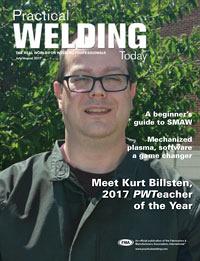- FMA
- The Fabricator
- FABTECH
- Canadian Metalworking
Categories
- Additive Manufacturing
- Aluminum Welding
- Arc Welding
- Assembly and Joining
- Automation and Robotics
- Bending and Forming
- Consumables
- Cutting and Weld Prep
- Electric Vehicles
- En Español
- Finishing
- Hydroforming
- Laser Cutting
- Laser Welding
- Machining
- Manufacturing Software
- Materials Handling
- Metals/Materials
- Oxyfuel Cutting
- Plasma Cutting
- Power Tools
- Punching and Other Holemaking
- Roll Forming
- Safety
- Sawing
- Shearing
- Shop Management
- Testing and Measuring
- Tube and Pipe Fabrication
- Tube and Pipe Production
- Waterjet Cutting
Industry Directory
Webcasts
Podcasts
FAB 40
Advertise
Subscribe
Account Login
Search
Determining weave bead width
- By Paul Cameron
- July 31, 2017
- Article
- Arc Welding
Q: When welding with 1/8-in. E7018 welding rods, what's the maximum width for weaving? I've heard different answers but can't find anything in the D1.1 structural code.
A: For the process you mentioned, shielded metal arc welding (SMAW) with E7018, you will not find many restrictions on weave/oscillation width in AWS D1.1, but there are some. Table 4.6 in Clause 4—"Qualification" limits weave/oscillation width in Charpy V-notch (CVN) testing applications by restricting heat input and weld metal volume (see: Electrical Characteristics 9). Travel speed plays a key role in both those calculations, and weave width has a direct impact on travel speed (the wider the weave, the slower the weld progression, or travel).
With other processes, such as gas metal arc welding or flux-cored arc welding, weave width is governed by the "split layer" limitations of Table 3.6, Note e; the travel speed limitations of Table 4.5 (see: 18); and the heat input/volume limitations of Table 4.6 (see: 9).
Long story short, what you're looking for most likely will not come from a code book. Information may be available from the electrode manufacturer or found in the electrode specification (Example: A5.XX), but for the most part, determining maximum weave width comes from years of testing and trying.
During my time as a weld engineer, I've come up with weave width limitations that I have found to work in my applications. They were not limitations listed on a weld procedure specification (WPS) because of a code requirement, they were listed on the WPS because of the engineer’s requirement—my requirement.
I'm sure you came looking for a hard-and-fast number you could use to determine weave or oscillation width, but that is a number that you will need to calculate on your own with your specific process, electrode, and customer’s or manufacturer’s requirements in mind.
About the Author

Paul Cameron
Braun Intertec
4210 Highway 14 East
Rochester, MN 55904
About the Publication
subscribe now

The Welder, formerly known as Practical Welding Today, is a showcase of the real people who make the products we use and work with every day. This magazine has served the welding community in North America well for more than 20 years.
start your free subscription- Stay connected from anywhere

Easily access valuable industry resources now with full access to the digital edition of The Fabricator.

Easily access valuable industry resources now with full access to the digital edition of The Welder.

Easily access valuable industry resources now with full access to the digital edition of The Tube and Pipe Journal.
- Podcasting
- Podcast:
- The Fabricator Podcast
- Published:
- 04/30/2024
- Running Time:
- 53:00
Seth Feldman of Iowa-based Wertzbaugher Services joins The Fabricator Podcast to offer his take as a Gen Zer...
- Industry Events
16th Annual Safety Conference
- April 30 - May 1, 2024
- Elgin,
Pipe and Tube Conference
- May 21 - 22, 2024
- Omaha, NE
World-Class Roll Forming Workshop
- June 5 - 6, 2024
- Louisville, KY
Advanced Laser Application Workshop
- June 25 - 27, 2024
- Novi, MI
































